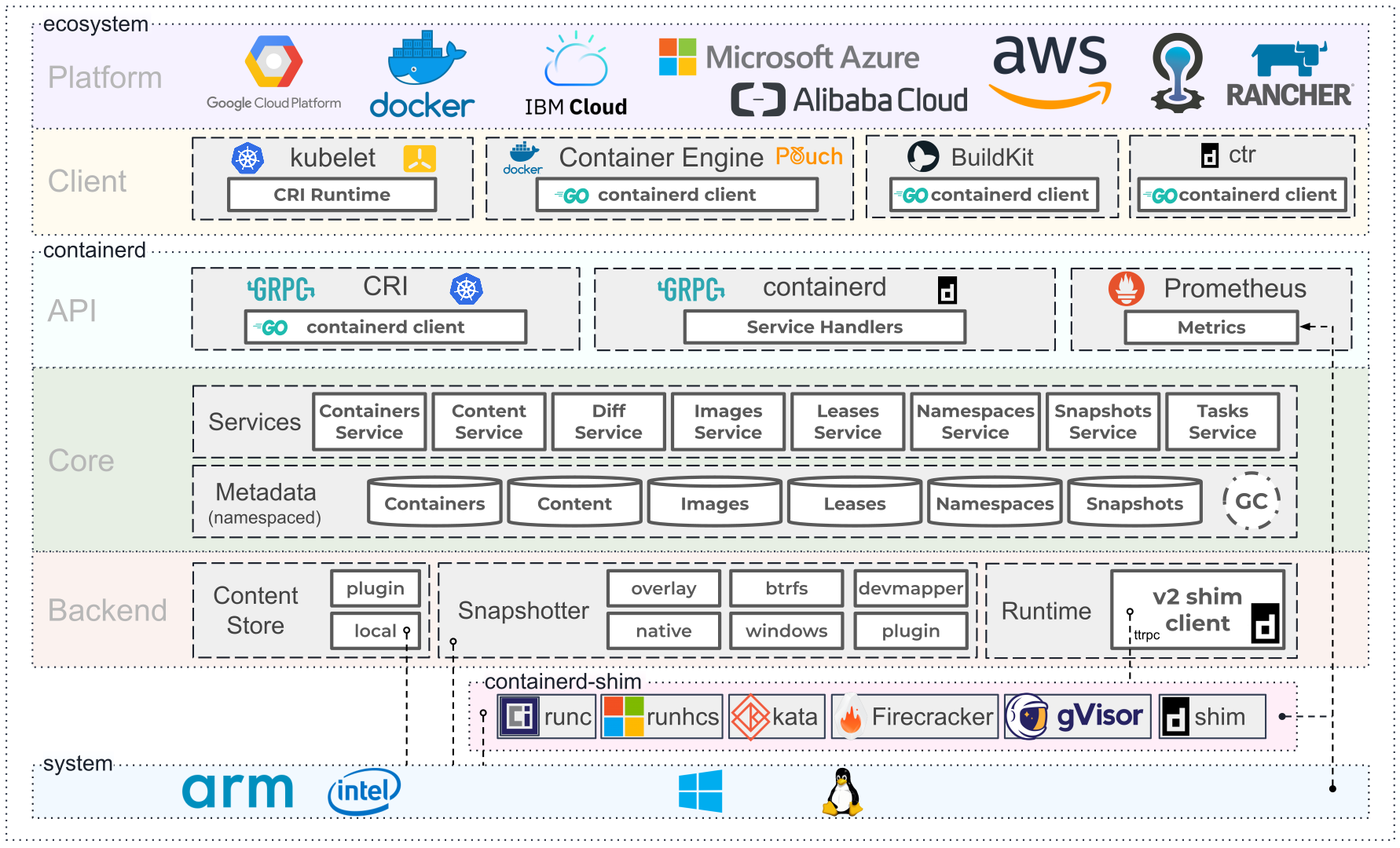Architecture of containerd

This diagram represents the architecture of containerd, an industry-standard core container runtime. It is designed to be less opinionated and can be used as a base for building a more complex container platform. Let’s break down the architecture depicted in the image:
Ecosystem Layer
The topmost layer is the ecosystem that interacts with containerd. It includes:
Platforms: Cloud platforms and container orchestration systems that use containerd as their runtime, such as Google Cloud Platform, Docker, IBM Cloud, Microsoft Azure, Alibaba Cloud, AWS, and others.
Clients: Tools that interact with containerd, like kubectl for Kubernetes, Docker CLI, ctr (containerd’s own CLI tool), BuildKit for building containers, and others.
CRI Runtime: containerd is compatible with the Kubernetes Container Runtime Interface (CRI), making it possible to use containerd as the runtime in Kubernetes.
containerd Layer
This is the core of containerd, divided into several components:
API: The gRPC API layer through which clients communicate with containerd. It defines service handlers for various container management tasks.
Service Handlers: These are gRPC services that handle API requests. They include services for managing containers, images, snapshots, tasks, namespaces, and more.
Core Layer
This is where the main functionality of containerd resides:
Services: These are the backend services that do the actual work. They include: Containers Service: Manages container metadata.
Content Service: Manages the storage and retrieval of content like layers and config.
Diff Service: Handles layer diff computations.
Images Service: Manages image metadata. Leases Service: Manages client leases for resources.
Namespaces Service: Provides multi-tenancy by segregating resources per namespace.
Snapshots Service: Manages filesystem snapshots.
Tasks Service: Manages the execution of containers.
Backend Layer
The backend consists of the components that interact with the host system:
Content Store: Storage for content like container images. This can be local storage or a plugin.
Snapshotter: Handles the creation of filesystem snapshots. There are various snapshotter plugins available, including overlay, btrfs, devmapper, native, and windows.
Runtime: This is where the containers are actually run. containerd supports multiple runtimes:
runc: The default OCI runtime for Linux containers.
runhcs: A runtime for running Windows containers.
Kata Containers: Provides lightweight VMs that offer more isolation than traditional container environments.
Firecracker: A microVM manager for creating and managing microVMs. gVisor: A user-space kernel for providing sandboxed environments.
V2 shim client: A newer version of the shim that manages the lifecycle of the containers and the host processes related to it.
System Layer
The bottom layer represents the system dependencies:
Operating Systems: The diagram shows containerd being compatible with ARM and Intel architectures, indicating cross-platform support.
Linux Penguins: Symbolizes that containerd is a Linux-native technology, but it also supports Windows as indicated by the “windows” snapshotter. Metrics Off to the side, there is a connection to Prometheus, which is a monitoring system that collects metrics. containerd has built-in support for exporting metrics that Prometheus can scrape and use for monitoring and alerting.
Overall, containerd is designed to handle the lifecycle of containers and images in a container system, manage storage and execution, and allow for extensive customization through plugins and external tooling. It is a key component in many modern container platforms, offering a balance between functionality and flexibility.
Last updated 03 Jun 2024, 13:43 +0530 .